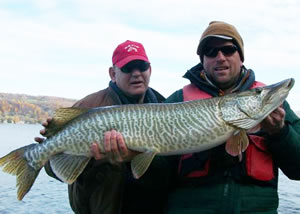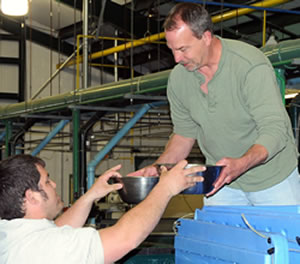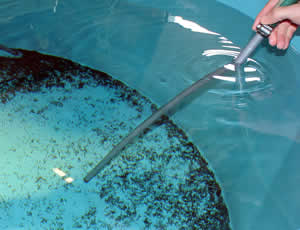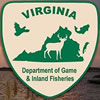 |
New Jersey's Tiny Contributions Yield Big Results for Neighbors |
|
by Craig Lemon
Hatchery Superintendent
June 9, 2015
|
Thanks to cooperative interstate arrangements established over the past 35 years, New Jersey now has several successful coolwater fisheries programs. These include Tiger Muskellunge (1979), Northern Pike (1981), Walleye (1989), and Muskellunge (1993). The programs began with eggs procured from other state's fish culture facilities, including those operated by the Pennsylvania Fish and Boat Commission, New York DEC, and even the Ontario Ministry of Natural Resources and Forestry. The donated eggs were hatched at the Hackettstown State Fish Hatchery, grown to fingerling sizes and stocked in suitable lakes. In the years to follow regional biologists sampled growing populations using gill nets, trapnets and electrofishing gear.
By 1995, New Jersey had established its own source of broodstock for all four of these species. In the twenty years that have followed, New Jersey's coolwater culture and stocking programs have proven successful in creating some excellent fisheries. These successes, in combination with facility upgrades in 1999, have allowed the Hackettstown Hatchery to give back to surrounding states. Today, fish culture operations here and in Pennsylvania, New York, Connecticut, Massachusetts, and Virginia produce surplus fry and fingerlings, enabling fish swapping between state-operated facilities - with anglers reaping the benefits.
|

NJ fry yield a big NY Tiger!
Click to enlarge |

Northern pike fry are turned over to Connecticut fisheries staff
Click to enlarge |
Anglers might ask, "Why are there these fish surpluses, and why aren't the fish being stocked in NJ waters?" Basically, the state's waterbodies can support only a finite number of fish of any particular species. State fisheries biologists continually survey the fresh waters of New Jersey and annually determine stocking quotas for each by species and size. They also provide the hatchery with options, such as major rivers like the Delaware and Passaic, where a number of surplus can be stocked. Staff at the hatchery then decide how many broodstock of each species should be captured to spawn the required number of eggs to reach these goals.
As hatching success varies greatly from species to species and from year to year, extra eggs are needed to ensure quotas are met. If there is one thing I have learned in my career at the hatchery, it is that there are very few things that you can count on being the same from year to year. Mother Nature also plays a big role in how a season goes. It could be late ice-out on broodstock lakes and the fish spawn under the ice, or a strong cold front can come through and push fish off their nests. Such conditions can greatly impact a hatchery's ability to meet necessary numbers. Invariably, however, there are certain numbers of surplus fish available each year. Once the surplus has been utilized within New Jersey, the needs and requests of surrounding states are investigated. |
New Jersey regularly supplies Northern Pike, Muskellunge, Tiger Muskie, Hybrid Striped Bass and Channel Catfish to surrounding states. Looking at some of the numbers of surplus fish and eggs given away this spring, one might say that 100,000 Tiger Muskies to New York or 100,000 Northern Pike fry to Connecticut seems a bit much. This actually equates to hatchery staff only spawning a handful more fish of each species. These big coolwater broodstock will each produce 50,000 to 100,000 eggs.
|
In April 2014, a crew from New York's South Otselic Fish Hatchery travelled here to pick up 120,000 one-week-old Tiger Muskie fry. These same fish culturists transformed the two pounds of fry into 111,000 ten-inch fingerlings weighing 15,000 pounds by fall. The fingerlings were stocked in 46 different water bodies throughout New York.
New Jersey anglers have benefited most recently from the fish trade program receiving Landlocked Salmon fingerlings annually from the State of Massachusetts Roger Reed Salmon Hatchery. Massachusetts fisheries staff made the day trip mid-May and delivered 2,000 eight-inch salmon and left with 15,000 two-inch surplus Northern Pike. These salmon will be grown at the hatchery and stocked in Tilcon Lake, Lake Aeroflex and Wawayanda Lake as fourteen-inch fish this fall. All fish involved in these trades come with a clean bill of health certified by state Fish Pathologists. Pathologists test all lots and species of fish raised at the hatcheries. (See Landlocked Salmon in New Jersey for more on this exciting fishery.)
Most recently the hatchery received a phone call from Massachusetts offering another surplus 2,000 salmon for the fall that will be 12 inches in length. The hatchery also received an e-mail from the State of Virginia offering surplus Walleye fingerlings. New Jersey had provided Virginia with 1,500 four-inch Northern Pike last summer.
|

Tiger muskie fry are gathered for shipping
Click to enlarge
|
Ongoing relationships such as these contribute to the thriving fisheries in New Jersey and other states in our region. New Jersey anglers have benefited greatly from these fish exchanges, and the future remains bright for more great fishing in the state's waters.
|









